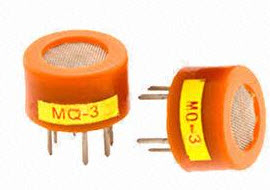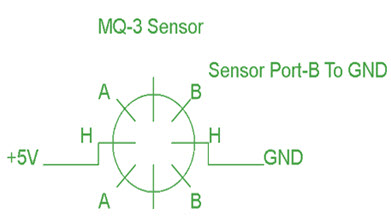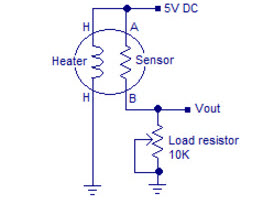What is an Alcohol Sensor?
This alcohol sensor is suitable for detecting alcohol concentration on
your breath, just like your common breathalyzer. Sensor provides an
analog resistive output based on alcohol concentration.
An alcohol sensor detects the attentiveness of alcohol gas in the air
and an analog voltage is an output reading. The sensor can activate at
temperatures ranging from -10 to 50° C with a power supply is less than
150 Ma to 5V. The sensing range is from 0.04 mg/L to 4 mg/L, which is
suitable for breathalyzers.

Basic Pin Configuration Of Alcohol Sensor
The
MQ-3 alcohol gas sensor consists of total 6-pins including A, H, B and
the other three pins are A, H, B out of the total 6-pins we use only 4
pins. The two pins A, H are used for the heating purpose and the other
two pins are used for the ground and power. There is a heating system
inside the sensor, which is made up of aluminium oxide, tin dioxide. It
has heat coils to produce heat, and thus it is used as a heat sensor.
The below diagram shows the pin diagram and the configuration of the
MQ-3 alcohol sensor.

Working Principle And Circuit Diagram
The MQ-3 alcohol sensor consists of a tin dioxide (SnO2), a perspective
layer inside aluminium oxide micro tubes (measuring electrodes) and a
heating element inside a tubular casing. The end face of the sensor is
enclosed by a stainless steel net and the back side holds the
connection terminals. Ethyl alcohol present in the breath is oxidized
into acetic acid passing through the heat element. With the ethyl
alcohol cascade on the tin dioxide sensing layer, the resistance
decreases. By using the external load resistance the resistance
variation is converted into a suitable voltage variation. The circuit
diagram and the connection arrangement of an MQ-3 alcohol is shown
below.

Applications Of MQ-3 Alcohol Sensor
The following are the applications of the MQ-3 alcohol sensor:
- Alcohol monitor
Characteristics Of MQ-3
- Good sensitivity to alcohol in wide range.
- It has long life and low cost.
- It is a simple drive circuit
No comments:
Post a Comment